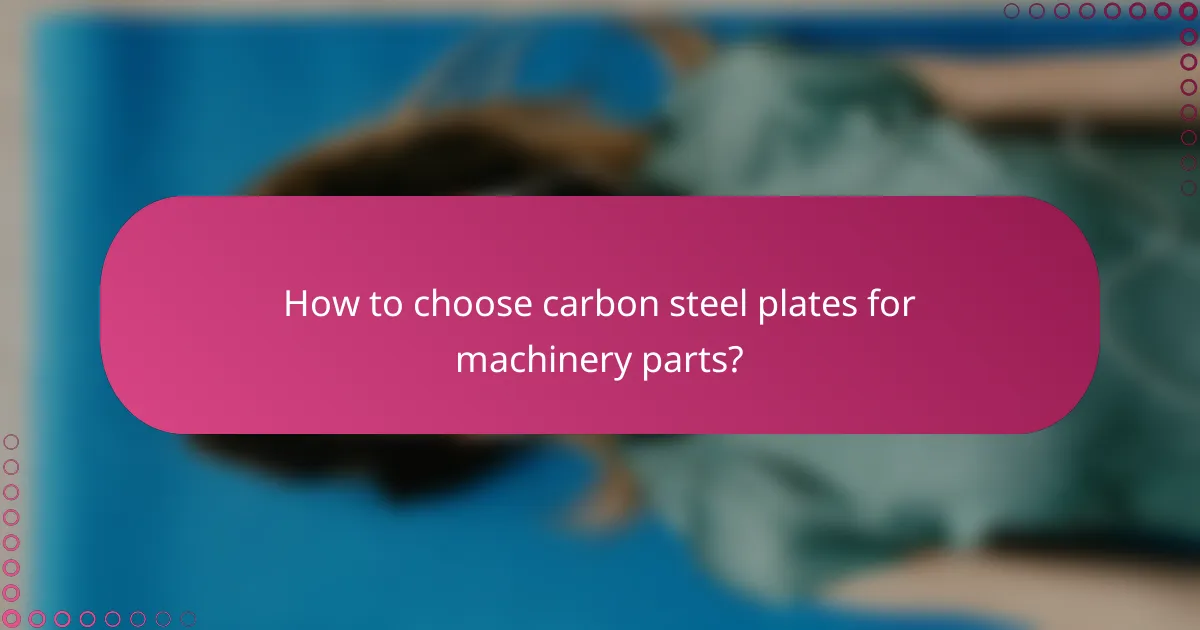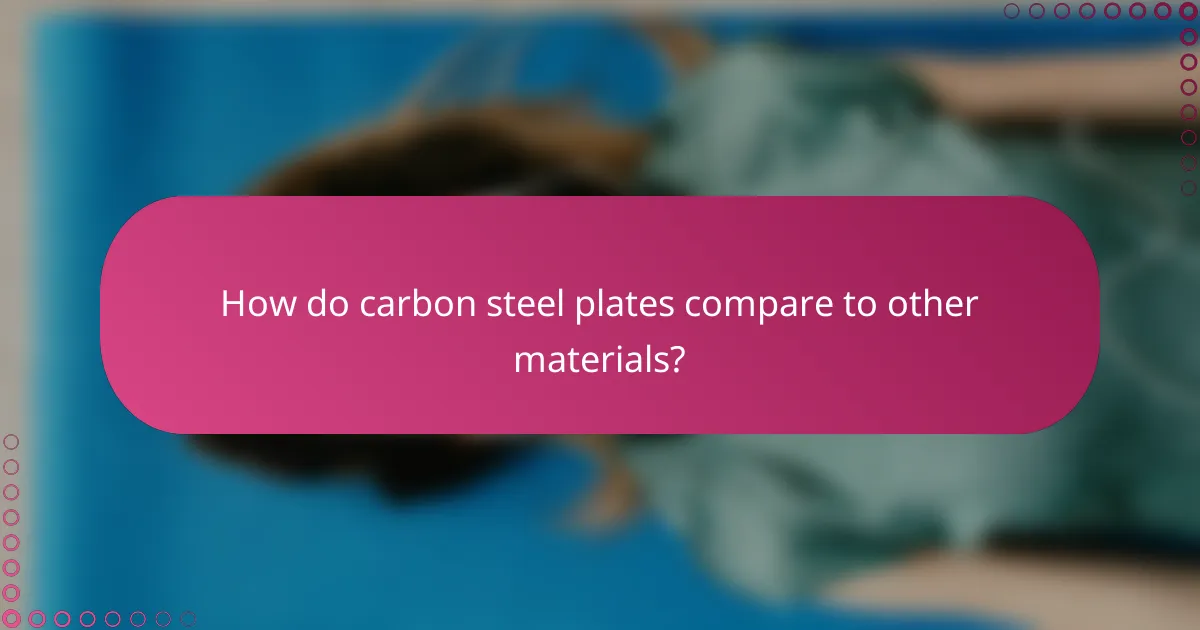Carbon steel plates are essential materials in various industries, particularly for structural beams, machinery parts, and automotive frames. Known for their strength, weldability, and versatility, these plates are often selected based on specific application requirements to ensure optimal performance and durability. Their cost-effectiveness further enhances their appeal in manufacturing processes, making them a preferred choice for engineers and manufacturers alike.

What are the best carbon steel plates for structural beams?
The best carbon steel plates for structural beams typically include ASTM A36, ASTM A572, and ASTM A992. These materials are favored for their strength, weldability, and versatility in construction and engineering applications.
ASTM A36 carbon steel plates
ASTM A36 carbon steel plates are widely used in construction due to their excellent weldability and machinability. This grade offers a minimum yield strength of around 36,000 psi, making it suitable for a variety of structural applications.
When selecting A36 plates, consider their thickness, as they are available in a range from 1/8 inch to several inches thick. Common applications include beams, columns, and general structural components.
ASTM A572 carbon steel plates
ASTM A572 carbon steel plates are known for their higher strength compared to A36, with yield strengths ranging from 42,000 to 65,000 psi, depending on the specific grade. This makes A572 ideal for applications requiring enhanced strength-to-weight ratios.
It is often used in bridges, buildings, and other structures where weight savings are critical. When using A572, ensure that the grade matches the structural requirements of your project.
ASTM A992 carbon steel plates
ASTM A992 carbon steel plates are specifically designed for structural steel shapes and are recognized for their excellent weldability and high strength, with a minimum yield strength of 50,000 psi. This grade is commonly used in modern steel construction.
When choosing A992 plates, consider their application in beams and columns, especially in high-rise buildings and bridges. Their performance under load and resistance to lateral-torsional buckling make them a preferred choice for structural engineers.

How to choose carbon steel plates for machinery parts?
Choosing carbon steel plates for machinery parts involves assessing the specific requirements of your application, including strength, weight, and durability. Consider factors such as thickness, material grade, and the intended use to ensure optimal performance and longevity.
Thickness and weight specifications
The thickness of carbon steel plates typically ranges from a few millimeters to several centimeters, depending on the application. For machinery parts, a thickness of 5-20 mm is common, balancing strength and weight effectively.
Weight is another critical factor, as it can impact the overall design and functionality of the machinery. When selecting plates, calculate the total weight based on the dimensions and thickness to ensure compatibility with the machinery’s design and load-bearing capacity.
Material grade considerations
Material grades for carbon steel plates are categorized based on their carbon content and mechanical properties. Common grades include ASTM A36 for general structural use and ASTM A572 for higher strength applications.
When selecting a grade, consider the specific mechanical requirements of your machinery parts, such as tensile strength and ductility. Higher-grade materials may offer better performance but can also increase costs, so weigh the benefits against your budget constraints.

What are the advantages of carbon steel plates in automotive frames?
Carbon steel plates offer significant advantages in automotive frames, primarily due to their strength, durability, and cost-effectiveness. These properties make them an ideal choice for manufacturers looking to enhance vehicle performance while managing production costs.
High strength-to-weight ratio
The high strength-to-weight ratio of carbon steel plates allows automotive manufacturers to create lighter frames without sacrificing structural integrity. This is crucial for improving fuel efficiency and overall vehicle performance.
For instance, using carbon steel plates can reduce the weight of an automotive frame by a notable percentage compared to heavier materials like cast iron. This reduction in weight contributes to better handling and acceleration, making vehicles more responsive on the road.
Cost-effectiveness
Carbon steel plates are generally more affordable than alternative materials such as aluminum or advanced composites, making them a cost-effective option for automotive production. Their lower material costs can significantly impact the overall budget of vehicle manufacturing.
Additionally, carbon steel is widely available and can be easily processed, which further reduces production costs. Manufacturers can benefit from economies of scale, as carbon steel plates are commonly used across various industries, ensuring competitive pricing and supply stability.

What are the common applications of carbon steel plates?
Carbon steel plates are widely used in various industries due to their strength, durability, and versatility. Common applications include structural beams in construction, components in manufacturing machinery, and frames in automotive production.
Construction industry
In the construction industry, carbon steel plates serve as essential structural beams, providing the necessary support for buildings and bridges. Their high strength-to-weight ratio makes them ideal for load-bearing applications, ensuring stability and safety.
When selecting carbon steel plates for construction, consider factors such as thickness, yield strength, and corrosion resistance. Adhering to local building codes and standards, such as ASTM A36 in the U.S., ensures compliance and quality.
Manufacturing machinery
Carbon steel plates are integral to the manufacturing of machinery parts, where they are used for components like frames, bases, and housings. Their toughness and machinability allow for the production of durable and precise parts that can withstand heavy use.
When designing machinery with carbon steel plates, it’s crucial to assess the operational environment, including exposure to chemicals or extreme temperatures. Choosing the right grade, such as S235 or S355, can enhance performance and longevity.
Automotive production
In automotive production, carbon steel plates are commonly used for frames and body panels due to their excellent formability and strength. They contribute to the overall safety and structural integrity of vehicles, making them a preferred material in the industry.
Manufacturers often utilize advanced techniques like stamping and welding to shape carbon steel plates into complex automotive components. Ensuring proper surface treatment can prevent rust and enhance the aesthetic appeal of finished vehicles.

What are the key specifications for carbon steel plates?
Carbon steel plates are defined by their thickness, width, length, and surface finish, which are crucial for their application in structural beams, machinery parts, and automotive frames. Understanding these specifications helps in selecting the right plate for specific engineering needs.
Thickness range
The thickness of carbon steel plates typically varies from around 1.5 mm to 100 mm, depending on the application. Thicker plates are generally used for structural applications, while thinner plates may be suitable for automotive and machinery components. When selecting thickness, consider the load-bearing requirements and fabrication processes involved.
Width and length options
Carbon steel plates come in various widths and lengths, commonly ranging from 1 meter to 3 meters in width and up to 12 meters in length. Custom sizes are also available to meet specific project requirements. It’s important to choose dimensions that align with the design specifications to minimize waste and ensure compatibility with other components.
Surface finish types
Surface finishes for carbon steel plates can include hot-rolled, cold-rolled, and galvanized options. Hot-rolled plates typically have a rougher surface, suitable for structural applications, while cold-rolled plates offer a smoother finish ideal for precision parts. Galvanized finishes provide corrosion resistance, making them suitable for outdoor or humid environments.

How do carbon steel plates compare to other materials?
Carbon steel plates are often favored for their strength and versatility compared to other materials. They provide a cost-effective solution for applications in structural beams, machinery parts, and automotive frames, but their performance can vary significantly when compared to alternatives like stainless steel and aluminum.
Carbon steel vs. stainless steel
Carbon steel is generally stronger and more affordable than stainless steel, making it a popular choice for heavy-duty applications. However, stainless steel offers superior corrosion resistance, which is crucial in environments exposed to moisture or chemicals.
For instance, while carbon steel plates may be suitable for indoor structural applications, stainless steel is often preferred for outdoor or marine environments. When selecting between the two, consider the specific environmental conditions and budget constraints.
Carbon steel vs. aluminum
Carbon steel plates are denser and stronger than aluminum, which allows them to bear heavier loads. However, aluminum is significantly lighter, making it ideal for applications where weight reduction is critical, such as in automotive frames.
In terms of cost, carbon steel is typically less expensive than aluminum, which can be a deciding factor for large projects. When choosing between these materials, evaluate the trade-offs between weight, strength, and cost based on the intended use and performance requirements.

What are the shipping and return policies for carbon steel plates?
Shipping and return policies for carbon steel plates typically vary by supplier but generally include options for standard and expedited shipping, as well as specific return guidelines. Most suppliers will allow returns within a defined period, often contingent on the condition of the plates upon return.
Shipping Options
When ordering carbon steel plates, you can usually choose between standard shipping, which may take several days to a week, and expedited shipping for faster delivery. Shipping costs can vary based on the weight and dimensions of the plates, as well as the distance to the delivery location.
Some suppliers may offer free shipping on larger orders or for customers within a certain radius. Always confirm the shipping terms before finalizing your purchase to avoid unexpected fees.
Return Policies
Return policies for carbon steel plates often allow returns within a specific timeframe, typically ranging from 30 to 60 days after delivery. To qualify for a return, the plates usually must be in their original condition and packaging.
It’s advisable to check the supplier’s return policy details, as some may charge restocking fees or have restrictions on custom-cut plates. Ensure you keep all documentation and receipts to facilitate the return process.
Important Considerations
Before placing an order, consider the dimensions and specifications of the carbon steel plates you need, as this can affect both shipping costs and return eligibility. Additionally, verify if the supplier provides tracking information for your shipment to monitor its progress.
Be aware of the potential for damage during shipping, and inspect the plates upon arrival. If you notice any issues, report them to the supplier immediately to understand your options for return or replacement.


